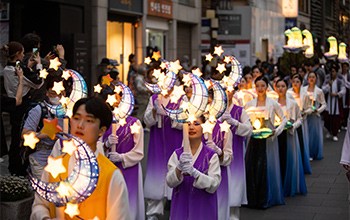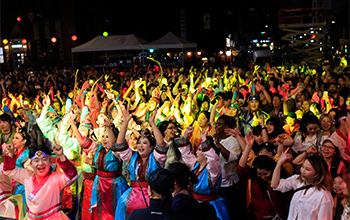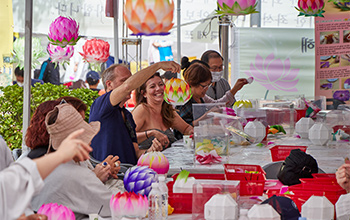-
Introduction
- Introduction
- 연등회에 참여하는 사람들은 자신이 직접 만든 등에 불을 밝히고
거리로 나서는데 이 등은 나와 이웃을 위한 마음의 등을 의미합니다.
각양각색의 전통등을 복원하기 위해서 전통등 작가들과 함께 잊히던
아름다운 전통 등문화를 전승하고 대중에게 알리고 있습니다. more+

-
Festival 2025
- Festival 2025
- 세계인의 문화축제로 발돋움하고 있는 연등회!
멋과 흥이 넘치는 연등회의 모든 일정을 알려드리오니,
연등회의 감동과 환희를 직접 함께 하시며 느껴보시기 바랍니다.
연등회의 일정은 사정상 다소 변경이 될 수 있으니 참고바랍니다. more+
- Exhibition of Traditional Lanterns
- Eoulim Madang
- Lantern Parade
- Daedong Hanmadang
- Traditional Cultural Events
- Cultural Performances
- Yeondeungnori
- Buddha’s Birthday Dharma Ceremony

-
Suggested Schedule
- Suggested Schedule
- 세계인의 문화축제로 발돋움하고 있는 연등회!
멋과 흥이 넘치는 연등회의 모든 일정을 알려드리오니,
연등회의 감동과 환희를 직접 함께 하시며 느껴보시기 바랍니다.
연등회의 일정은 사정상 다소 변경이 될 수 있으니 참고바랍니다. more+

-
Community
- Community
- 세계인의 문화축제로 발돋움하고 있는 연등회!
연등회 포스터 및 연등회 음악율동 자료와 등만드는 방법,
법요 문안모음 등을 확인 및 다운받으실 수 있습니다. more+

- English
- 한국어
- English
- 日本語
- 中文
- Français
- Deutsch
- Español
Free Board
The celebration of Buddha’s birthday in Korea must seem to some foreigners like a the blooming of a mysterious and magnificent flower that lurks beneath the surface of the earth for some 360 odd days and then around the end of April comes sprouting up with unbridled beauty and joy, only to sink back down again and disappear when those special days have passed. This was the feeling I got as I spent the day on the streets in front of Jogye-sa at the 2006 Lotus Lantern Festival and chatting with the many foreigners who came to join in the celebration.
<?xml:namespace prefix = o ns = "urn:schemas-microsoft-com:office:office" />
While I myself have been thoroughly immersed in Korean Buddhist culture for about a decade, knowing where to look to see the subterranean signs of Buddhism that exist almost everywhere in Korea, talking to my fellow expatriates at the festival clued me in to the fact that outside of the obvious signs ? temples, swastikas, and monks and nuns wandering here and there ? the presence of Buddhism simply didn’t register in their Korean experiences. This, then, represents perhaps the greatest triumph of the Lotus Lantern Festival. Each year, foreigners flock to downtown Seoul to catch a glimpse of a tradition they’ve certainly heard about, and seen from a distance, but perhaps have never really met up close. What a meeting the festival is!
For one thing, the festival offers Korean expressions of unadulterated joy. Everywhere one turns there are smiling faces, boisterous laughing, and exhortations to “Please become a Buddha!” (seongbul haseyo!). This joy culminates in the peak experience offered at the end of the lotus lantern parade in the group dancing (gang gang sulle) in front of the main stage, as “raining blossoms” filled the air above Jong-no, liberated for this one night from the mechanical monsters that normally lay exclusive claim to this prime real estate. This reclamation of the street by pedestrians is in and of itself a prime ingredient of the festival that aids the sense of joy and one I’m sure most everyone values even more than they initially realize. Only after returning to the street in front of Jogye-sa where a few days ago I had danced late into the night with a pungmul-pae from Dongguk University who simply refused to call it a night, did the pain of being restricted from freely wandering around become totally evident to me.
Yet, as important a role as the liberation of social space plays in creating the ground (madang) from which our joy in play can emerge, it is the personal characteristics of Korean Buddhists that give the nutrients to make that joy blossom. As a Buddhist, I myself took for granted that the festival would be a space of relaxed enjoyment. Some Buddhists from Sri Lanka reinforced this sense when they told me that coming to the festival made them feel “right at home” and part of a larger international Buddhist community. But after I interviewed other foreigners, I realized that their experiences were marked by a sharp perception that they were indeed taking part in the religious holiday of someone else’s religion, and thus, quite naturally, there was no small sense of anxiety involved. Yet in each case, they reported that this anxiety had been quickly relieved by the welcoming spirit of tolerance, sharing, and empathetic happiness that effused from the numerous volunteer workers, as well as those Korean Buddhist practitioners in attendance.
I could understand this sentiment perfectly. The two city blocks of the madang had packed within them a multitude of unique opportunities to explore, learn and enjoy oneself, and most of it was completely free! Become a disciple of the Buddha ? learn Seon meditation ? get a foot massage ? learn how to paint Buddhist art? make a lotus latern ? whatever you want. Or just walk around and take it all in. Whichever way you chose to take part, you could, in accordance with your own needs, desires, feelings, and capabilities. Perhaps best of all, there was no pressure for you to “believe in Buddha” for fear of otherwise being shunned. Just like the temple gates that stand wide open without a bar restricting entry only to “true believers,” the festival allowed anyone to take part at whatever level they felt comfortable. If there was any hardcore prostelyzing taking place, it was simply the demand that for a few hours on this one day, you try your very best to have a great time sharing this special place with the other members of your community.
It is here I felt the strongest sense of what the possibilities for Korean Buddhism can be. Seeing how many foreigners were in attendance at the festival and in the parade made me realize that Korean Buddhism has the resources available to make a vibrant community presence not only during the week around Buddha’s birthday, but all year round. Thus, I was extremely pleased to see a sign at Jogye-sa that advertised their support services for migrant workers in Korea, because as much as we all need to feel unadulterated joy now and then, the reality of the Buddha’s life is grounded in his transcendence of suffering and it is this suffering that we must acknowledge in our deepest of hearts, even on the most joyous of occasions.
This got me to thinking a little bit about the fact that while I was certainly excited that Korean Buddhism was once again making its face known during this holiday period, and that the promotion of Buddhism was linked with such a happy celebration, I couldn’t help but wonder why it was that Korean Buddhism hadn’t made a deeper impression on expatriates through their prominent appearance in times of great need and suffering. What I mean is that while I was glad that all the foreigners I talked to knew about the Lotus Lantern festival, I was a bit sad in realizing that nobody had said that they had known of Korean Buddhism because of the prominence of Buddhist homeless shelters, soup kitchens, relief services, or retirement communities that one couldn’t help but notice while going through one’s daily life in Korea. None of the foreigners I talked to every mentioned that they saw evidence of Korean Buddhism in the actions of their co-workers or neighbors who always went out of their way to help those who were suffering, or to be nice to animals, or to embrace a life of simplicity amidst a sea of conspicuous consumption and slavery to brand-names and fashion fads. While I don’t expect Korean Buddhist to constantly declare their religious identity, or get attached to it, yet, there is certainly no shame in letting the world know that you are Buddhist and what Buddhism can mean to making one’s life and one’s community better. Would that such day to day expressions of Buddhist garner as much prominent attention as the Lotus Lantern festival…
Still, it would be remiss to end on a note of regret, for this was indeed a day of triumph. Buddha’s birth and life and his triumph over suffering was, of course, the main triumph we had gathered to celebrate. But the Lotus Lantern Festival was itself a triumph: over the streets that normally block our ability to interact; over the alienation, tedium and boredom that often marks the stale routines of our daily lives; and over the gloomy and colorless pall cast upon the modern world by the state of constant war and the demands of limitless economic and political competition. For one day, a few streets in Seoul were ours to share in common ? and we had made the very most of it.



